Ask OSAP: Does jewelry cause cross-contamination?
“Ask OSAP” is a question and answer provided by the Office of Organization for Safety, Asepsis and Prevention, dentistry’s advocate for the safe and infection-free delivery of oral health care. This entry takes on the question of wearing jewelry and infection control.
Question: Is there a policy for wearing jewelry as a health-care provider in terms of infection control? For example, we have a policy that earrings, rings, and bracelets cannot be worn because they are a source for cross contamination and rings can puncture gloves or cause them to tear.
From OSAP: The CDC’s Guidelines for Infection Control in Dental Health-Care Settings1 includes several references to jewelry. Some points of that document include:
Before beginning surgical hand scrub, remove all arm jewelry and any hand jewelry that may make donning gloves more difficult, cause gloves to tear more readily (142, 143)*, or interfere with glove usage (e.g., the ability to wear the correct-sized glove or altered glove integrity).
Jewelry studies have demonstrated that skin underneath rings is more heavily colonized than comparable areas of skin on fingers without rings (167–170). In a study of intensive-care nurses, multivariable analysis determined rings were the only substantial risk factor for carriage of gram-negative bacilli and Staphylococcus aureus, and the concentration of organisms correlated with the number of rings worn (170).
However, two other studies demonstrated that mean bacterial colony counts on hands after handwashing were similar among persons wearing rings and those not wearing rings (169, 171).
Whether wearing rings increases the likelihood of transmitting a pathogen is unknown; further studies are needed to establish whether rings result in higher transmission of pathogens in health-care settings.
But rings and decorative nail jewelry can make donning gloves more difficult and cause gloves to tear more readily (142, 143). And jewelry should not interfere with glove use (e.g., impair ability to wear the correct-sized glove or alter glove integrity).
The FDA regulates the medical glove industry, which includes gloves marketed as sterile surgeon’s gloves and sterile or nonsterile patient examination gloves. General-purpose utility gloves are also used in dental health-care settings but are not regulated by the FDA because they are not promoted for medical use. More rigorous standards are applied to surgeon’s than to examination gloves.
The FDA has identified acceptable quality levels (e.g., maximum defects allowed) for glove manufacturers (214), but even intact gloves eventually fail with exposure to mechanical (e.g., sharps, fingernails, or jewelry) and chemical (e.g., dimethyacrylates) hazards and over time. These variables can be controlled, ultimately optimizing glove performance by users maintaining short fingernails, minimizing or eliminating hand jewelry, and using engineering and work-practice controls to avoid injuries with sharps.
The bottom line: Don’t wear hand or nail jewelry if it makes donning gloves more difficult or compromises the fit and integrity of the glove (123, 142, 143).
*parenthetical numbers refer to references within the CDC report
Interested in learning more? OSAP member benefits are designed to save you money and time, connect you with colleagues around the world, enhance your dental infection prevention, occupational health, and patient safety knowledge and skills, and help you meet your professional goals. Here's how to join.
References
1. Kohn WG, Collins AS, Cleveland JL, Harte JA, Eklund KJ, Malvitz DM. Centers for Disease Control and Prevention (CDC). Guidelines for infection control in dental health-care settings—2003. MMWR Recomm Rep 2003;52(RR-17):1-61. https://www.cdc.gov/mmwr/PDF/rr/rr5217.pdf Accessed on July 22, 2022.
2. Search terms “dental infection control, jewelry” on Google: https://www.google.com/search?q=dental+infection+control%2C+jewelry&rlz=1C1CHFX_enUS661US661&oq=dental+infection+control%2C+jewelry&aqs=chrome..69i57j33i160l4.14105j0j15&sourceid=chrome&ie=UTF-8 Accessed on July 22, 2022.
Thank you for your interest in the Organization for Safety, Asepsis and Prevention, dentistry’s advocate for the safe and infection-free delivery of oral healthcare.
About the Author
Elizabeth S. Leaver
Digital content manager
Elizabeth S. Leaver was the digital content manager for Endeavor Business Media's dental group from 2021-2024. She has a degree in journalism from Northeastern University in Boston and many years of experience working in niche industries specializing in creating content, editing, content marketing, and publishing digital and magazine content. She lives in the Boston area.
